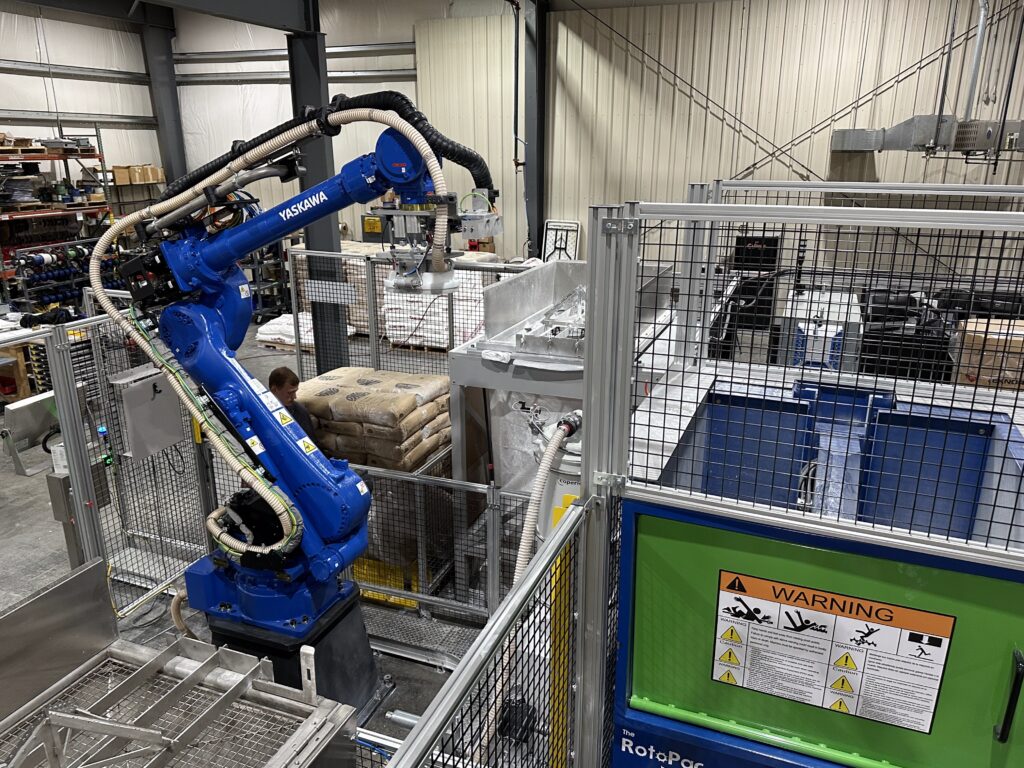Robotic Depalletizing Solutions
Modernize and Increase Worker Safety with Automated Depalletizing and Discharging
Depalletizing, unloading pallets for incoming materials, is highly suitable for automation using robotics. This solution is highly versatile; robotic depalletizing systems can handle various pallet configurations, product mixes, and packaging types. Robotic depalletizing systems increase throughput and accuracy in receiving operations, improving overall efficiency.
Automated depalletizing removes one of the most labor-intensive operations within your plant.


Tired of Manual Unloading That Slows Everything Down?
Manually handling incoming pallets can cause bottlenecks, safety concerns, and inconsistent product flow. Whether you are moving bags of powder, stacks of cases, or industrial components, this step often becomes a constraint in your process.
Don’t waste skilled labor on a job that is better done by a robot.
Automate Your Depalletizing—Without the Guesswork
Force Design helps manufacturers eliminate the stress of manual unloading by designing and building robotic depalletizing systems tailored to your specific materials, plant layout, and production flow.
- Plastic compounds (powders, pellets, pigments)
- Agricultural products (seeds, grains, granules)
- Baking and food ingredients
- Industrial parts and castings
What type of Depalletizing System do I need?
- Case Depalletizing: Flexible and efficient, picking cases one at a time with optional vision guidance for precise placement.
- Row Depalletizing: Picks full rows of identical products for faster cycle times. This method often utilizes a large vacuum end effector. Again, vision can be applied here for targeting.
- Full Layer Depalletizing: Ideal for high-volume applications using standardized EOAT to pick complete pallet layers.
- Custom Product Handling: Unstack unwieldy products like tires, castings, auto parts, and bulk metal for downstream operations such as sortation, machining, automated storage, or inspection.
- Bulk Material Handling: Depalletizing poly and paper bags of granular bulk materials. Secondary operations can include discharging the bag contents and discarding the bag.
Built around your Process Flow
The movement of materials through a manufacturing plant impacts the design of robotic depalletizing cells. Robotic depalletizing systems bring efficiency gains by providing consistent unstacking and material handling. We carefully consider the best ingress and egress options for your unique application.

Single Dock In / Out
Simple and compact, for operations with basic throughput needs.

Hot Swap
The Hot Swap setup enables an operator to replace an empty pallet with a full one while the robot depalletizes the pallet in the adjacent dock. This is achieved through multiple safety zones integrated with the robot controller’s safety module.

Multi-Dock Systems
Use 7th-axis robot rails to handle multiple pallets and discharge stations simultaneously.
Smart Tools for Smart Material Handling
- 2D and 3D Vision Systems: Standard pattern-based depalletizing fails with irregular stacks or inconsistent parts. In these cases, vision systems provide precise location and orientation data for robotic picking. Force Design evaluates top-tier solutions to ensure accurate targeting.
- Vision Software Options: Vision systems include AI-driven software for reliable object recognition. We assess each application to match the right tools with the task, working closely with leading providers to deliver the best-fit solution.
- Vacuum Grip End of Arm Tools: Force Design uses both Venturi and blower-style vacuum tools for pallet picking. Each has unique advantages depending on bag material, surface condition, and maintenance needs.
- Mechanical Grip End of Arm Tools – For certain applications, mechanical grippers—typically pneumatic—offer better control than vacuum-based tools.
- Application-Specific Design – We evaluate each project’s unique conditions to select the best EOAT and vision system. Validation testing will be performed at the Force Design, Inc. facility prior to project launch.
Optional Discharge and Conditioning Tools for Bulk Bags
- Horizontal Separator: For high-speed lines, horizontal separators open bags, discharge contents, and move empty bags to an auger compactor—all within an enclosed system that minimizes dust. Available through Force Design, they are fully integrated into the depalletizing cell controls.
- Open Blade Bag Discharge System: Ideal for up to three bags per minute, this system uses proven designs tailored to bag type and contents. Mounted over a stainless-steel hopper, it directs materials into downstream processing. Tooling is perishable and requires periodic maintenance.
- Bag Conditioner: Some powders compact (cold form) during shipping, forming solid masses. Force Design can provide bag conditioners to break up these materials before discharge, fully integrated into the depalletizing system’s controls.
- Bag Compactor: Empty bags from the discharge process can be managed using a commercial compactor, supplied by Force Design. This system is seamlessly integrated into the depalletizing cell control system.
- Air Filtration / Dust Collection: When automating systems that handle granular materials, dust control is critical. Force Design’s engineers evaluate all relevant factors—like material type and environmental conditions—to recommend the right dust collection system for your operation or we can integrate the depalletizing cell with a plant-wide system.
Start Your Depalletizing Project with Confidence
We make it easy to get started: